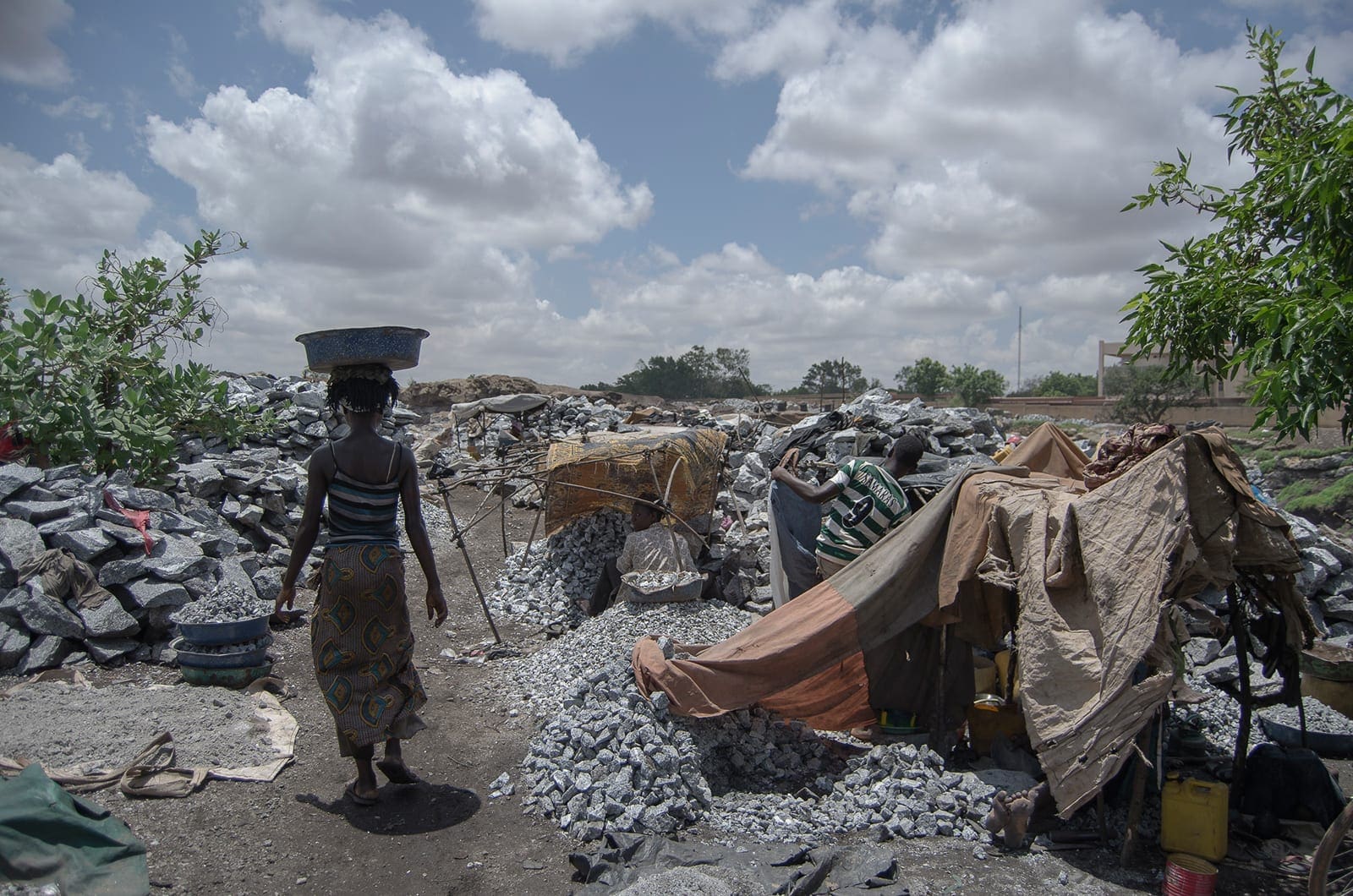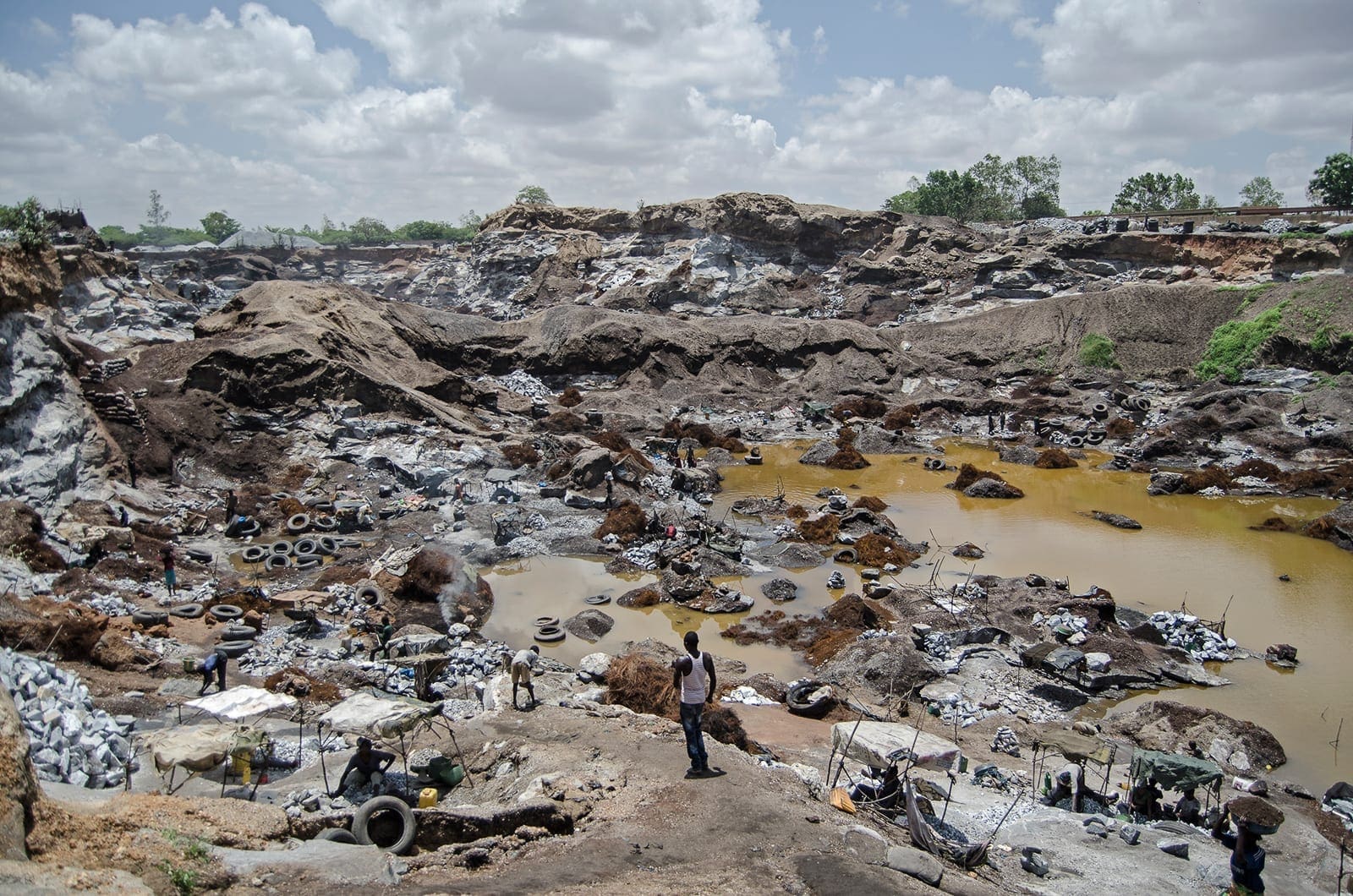As soon as you cross the entrance, the first thing that strikes you is the sound of hundreds of small mortars, used to crush granite. A constant tinkling covers all other noise. Soon after comes the acrid smell of burning tyres, which makes the air almost unbreathable. And dust. A world apart, made of stones, toil and sweat. This is the Pissy granite quarry, located a few minutes from the centre of Ouagadougou, the capital of Burkina Faso. It is an open-cast mine, where more than three thousand people work, among them mainly women and many children. The quarry is close to the town centre and for this reason, it is not possible to use explosives: all the work is done exclusively by hand, from the extraction of the granite to the reduction into stones of various sizes. The extraction of the blocks is facilitated by burning plastic material that creates micro-fractures inside the rock.
Here people work under extreme conditions, without any safety regulations. Subjected to fatigue, heat (the temperature in the dry season can reach fifty degrees) and air contaminated by dioxin from burning tyres, the workers spend their days in a hostile environment. The working day is tough, up to twelve hours, and the earnings depend on the amount of stone extracted or processed. If you have a good day, you can get just a little bit more than one euro. What could be described as a circle of hell, where a block of granite is mined and turned into powder without the aid of any machinery, is for many the only way to survival.

In the quarry, there are no shaded areas and the only shelter is small huts, built with makeshift materials, which become shelter and a place to work. Next to the mortars are plates, pots and a few bottles. Some of the children work as street vendors selling drinks and food, and with their carts, they spend the day traversing the dusty streets of this open-air mine. In an incessant back and forth, women with faces marked with rivulets of sweat, carry blocks of granite from the crater of the quarry towards the surface. Transporting the material is dangerous. It is difficult to navigate these steep and winding paths when one has to balance a load of no less than fifty kilos. Fatigue and resignation seem to characterise the lives of these people.
There is a definite hierarchy in the quarry. The organisation of work and the trade of large quantities of granite are managed exclusively by the men. They control production and decide who can enter the quarry. In addition to transporting the materials, women take care of the stone crushing and, at the same time, the children. As does the girl who works at the mortar with her child. Her smile is not dimmed by the dust that almost completely envelops her and turns her eyelashes and nostrils grey. An image of grace and beauty that contrasts with the real consequences to which continuous exposure to granite dust can lead. Respiratory problems and lung infections are among the most common illnesses.
A child of fewer than ten years old carries a large stone on his head and walks barefoot in the sun. Like the adults, he silently endures the dust and heat and in his gaze is everything that a lost childhood means. Precisely to combat child labour, a large sign stands at the entrance to the mine stating that working in the quarry is dangerous for children, who should instead go to school. Unfortunately, the reality is very different. In Burkina Faso, despite projects to eliminate child labour, thousands of children are still employed in the mines, trying to support themselves and their families. The Pissy quarry is not an exception.

Burkina Faso is one of the poorest countries in the world. With a Human Development Index of 0.452 it ranks 182nd out of 189 countries*. According to a 2010 study conducted by UNICEF.** and the government of Burkina Faso, about 20 thousand children were being used in artisanal mines, and more than 80 percent had never been to school. In 2018, according to data from the Bureau of International Labor Affairs (ILAB).***, Burkina Faso made moderate progress in its efforts to eliminate child labor. Indeed, the government has removed more than two thousand children from mining sites and placed them in the care of social services. However, much remains to be done. Many children continue to accompany their mothers to work from a very young age, and when they are a little older and able to carry heavier loads, they start working. Mining represents for many of them the only possible future.
Data Source
*HumanDevelopment Report 2020 UNDP | http://hdr.undp.org/sites/all/themes/hdr_theme/country-notes/BFA.pdf
**UNICEF | https://www.unicef.org/appeals/burkina-faso
***ILAB | https://www.ecoi.net/en/file/local/2017702/Burkina+Faso.pdf

